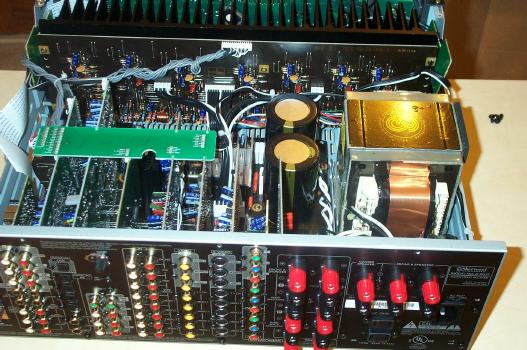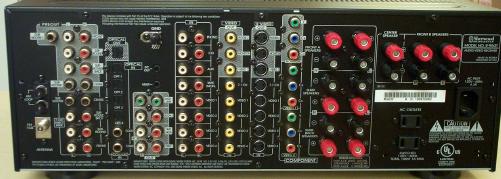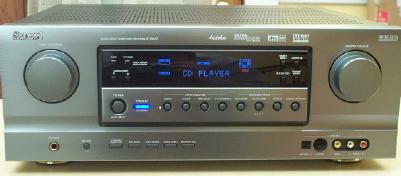Product Review - Sherwood Newcastle R-963T Surround Sound Receiver - May 2002
John Kotches, Editor PC/Home Theater
![]()
|
|
Manufacturer's
Specifications / Features
Inputs
MSRP US$1995 |
| Sherwood America, 2346 East Walnut Avenue, Fullterton, California 92831; Phone 800-962-3203; Web http://www.sherwoodusa.com/newcastle/index.htm |
Introduction
I first ran into the prototype of the Sherwood R-963 at CEDIA 2001, where I spoke with Jeff Hipps about the new Sherwood products. As with many A/V products today, I found that its introduction was delayed for a while, as the last of the kinks in implementation were being worked out. While many people get frustrated, I work in the computer industry and knowing the level of detail and complexity of these products, I can fully understand how and why they get delivered late. It's never intentional, and there are logical reasons (like working out a bug in a codec or other such items) that add days, weeks, and sometimes months to a product's initial delivery.
So the question is, was the wait worth it? I'm going to torture you somewhat and say "Read on dear reader, read on!".
Out of the box, and into System B
I started off by unpacking the receiver and taking my usual array of "mug shots" - the series of photos you see in this review. Even though the photographic subject isn't particularly nimble, I still managed to roll off the usual few expletives from my tongue, mostly decrying a lack of adequate lighting in my house. Thank God for 500w contractor lights, the ultimate in task lighting!
This product is available in two finishes, with two different nomenclatures. The R-963 is the receiver with a black face plate. I received the R-963T, which is the receiver with a titanium colored faceplate. Come to think of it, for a receiver, it does have an understated, rugged handsomeness, doesn't it?
Let's take a look under the hood, and see if any goodies are waiting for us.
 As
you can see - it's YACCC (Yet Another Card Cage Construction). This
modular approach allows for (theoretically) simple upgrades and repairs.
Unplug the module to be upgraded (or repaired) and snap in the
replacement. Voila` , it's done. In addition, behind the front panel
(right side of the picture) is the heat sink for the amplifier section.
Even during extended operation at high volume level, the front and top panels
never got unduly warm, indicating both a lot of surface area for radiating waste
heat away, and reasonable efficiency. In other words, there's less heat to
radiate away to begin with.
As
you can see - it's YACCC (Yet Another Card Cage Construction). This
modular approach allows for (theoretically) simple upgrades and repairs.
Unplug the module to be upgraded (or repaired) and snap in the
replacement. Voila` , it's done. In addition, behind the front panel
(right side of the picture) is the heat sink for the amplifier section.
Even during extended operation at high volume level, the front and top panels
never got unduly warm, indicating both a lot of surface area for radiating waste
heat away, and reasonable efficiency. In other words, there's less heat to
radiate away to begin with.
The modern A/V receiver wouldn't be complete without a googleplex of I/O - and there seem to be contests afoot to determine who can shove the largest number of connectors into the smallest space. Fortunately, this receiver doesn't seem interested in entering that contest.
 The
I/O is nicely organized, with relatively speaking "tons of space"
between the various and sundry inputs.
The
I/O is nicely organized, with relatively speaking "tons of space"
between the various and sundry inputs.
From left to right we have: Antenna inputs for FM & AM. Next are preamp outputs for all channels (7 mains, and a pair of subwoofer outputs too!) Below that is the multi-channel input for a potential 7.1 of speakers - this allows you to hook up to either side or rear surrounds. I could see a potential use for the extra two inputs from a 5.1 source (DVD-A) where the rear surrounds could get a copy of CC and subwoofer, so that the Chesky, Telarc and MDG 6 channel formats could be used without reconnecting everything. All main channels have five-way binding posts (not gold plated). We won't talk about the appearance with most of these connections used up though, because that's another story altogether. As you can imagine, it gets quite crowded with 5 (or 7) speaker connections plugged in. The R-963 also sports an MM phono input for turntables.
Features, get your features here . . . .
With out trying to sound derogatory, it seems like our A/V receivers are in a battle to "out feature" each other. This receiver is almost fully buzz-format compliant - sporting the following decoding / processing features:
| PCM to 24bit/96k input | Dolby Pro-Logic 2 (Music & Movie) | DTS | 12 DSP Surround Modes (the usual suspects) |
| Upsampling PCM to 24bit/192k | Dolby Digital | DTS-ES (Discrete & Matrix) | Surround ES processing 6.1/7.1 from 5.1 (Crystal DSP feature) |
| DTS Neo:6 (Music & Movie) | MP3 |
That's just the digital side of things. In addition, the R-963 has stereo and multi-channel analog bypass. All bass management is performed in the analog domain with a fixed crossover frequency of 80 Hz.
In case you haven't figured it out, there is one "feature" that's missing. Notice the ES processing listed? It's similar to THX Surround EX, but is not that product. In essence, it is not THX-certified, but delivers similar functions.
The User Interface, trouble in paradise?
Everytime we work with a receiver, we touch the user interface. This can be something as simple as punching buttons on the remote control, up to and including speaker configuration. Below, the term OSD refers to the On-Screen Display.
 One
area that cannot be bypassed is the remote control (pictured at
left). Many manufacturers don't build their own remote controls,
they go to an OEM that specializes in remotes. In this case, it's the
Universal Remote Control MX-500. It's on the large side for remotes, but
because of its shape, it does fit into one hand easily enough. One handed
operation? Challenging, but workable. I like the backlight touch,
which is a button on the right side of the remote - this allows for easy
operation in a darkened theater. Given my transition to a very dark
environment for FPTV (Front Projection TV), the inclusion of backlighting for remotes has become
increasingly important. (I painted my home theater black.)
One
area that cannot be bypassed is the remote control (pictured at
left). Many manufacturers don't build their own remote controls,
they go to an OEM that specializes in remotes. In this case, it's the
Universal Remote Control MX-500. It's on the large side for remotes, but
because of its shape, it does fit into one hand easily enough. One handed
operation? Challenging, but workable. I like the backlight touch,
which is a button on the right side of the remote - this allows for easy
operation in a darkened theater. Given my transition to a very dark
environment for FPTV (Front Projection TV), the inclusion of backlighting for remotes has become
increasingly important. (I painted my home theater black.)
This is a preprogrammed for the R-963, obviously. During my review period I had occasion to use it with a Toshiba DVD player and an Echostar Satellite receiver. The Echostar worked flawlessly; however the Toshiba DVD required some effort to get common functions working correctly. Given that this is a latest model year Toshiba, the result is not at all surprising, but a few minutes with the remote control manual in hand solved that problem handily by teaching the appropriate codes to the correct buttons.
Source selection is from the series of "hard buttons" at top. The LCD display is just that, a display, so it is not an active, touch sensitive panel. The Audio section has two pages - and pictured is Page 2, which allows you to chose decoding formats and the 7.1 Input. Page 1 has source selections.
I found the remote sensor to be more sensitive to remote aim than most, and a tight window was needed to get the remote to work correctly. Unfortunately I could not get a Xantech IR emitter to work with the R-963 properly. This is a disappointment, and something that is a non-issue for many users, but it is for me, so I'm talking about it. There is no back panel option for input of remote commands via electrical signals as an alternative.
System setup is accomplished after selecting OSD. Here you can configure Power Amp assignments, specifically, Channels 6+7, corresponding to rear surrounds can be reutilized as the amplifiers for Zone 2 - a welcome touch if you only have a 5.1 setup.
Configuring speakers is relatively straightforward. After selecting Speaker setup from the OSD menu, there are three sub-menus for speakers: Speaker Config which is used for configuring the presence of particular speakers, and when installed, their size. This interacts with bass management. Speaker distance is entered in either feet or meters, as measured from the primary listening position. Speaker distances range from 1 to 30 feet (0.3 - 9.0 meters).
An LFE level control is also provided to allow for attenuation up to 10 dB for Dolby Digital and -10dB to +10dB trim for DTS and MPEG decoding. I would like to see this implemented in more processors/receivers.
Digital inputs can be assigned to various named inputs. As an example, CD can be assigned Coax 1, and Video 1 can be assigned Optical 1, etc. The inputs are labeled clearly on the back panel, so record the assignments you want as you go along. Video inputs can also be assigned to various input options, but hidden away in the manual is the ability to monitor the 7.1 channel input, when plugged into the 7.1 Video input. The video inputs can be renamed, so that instead of seeing Video 1 COA1, you can see Kenwood COA1, Sat OPT1, [Review piece name] COA2 etc. Then, you can change the label on the Remote Control to match. The process works, but is a bit cumbersome for the receiver side. Once you do this, it makes life a lot easier, as you can assign names that are more meaningful than VIDEO 1, VIDEO 2 etc.
Besides the remote, you can also control most of the functions of the receiver from the front panel. The one thing you can't do is go to a discrete input. When selecting a video source, you must cycle through the choices, and the same holds true for audio sources. Since 99+% of the time you will be using the remote control for these functions, it's no problem from my point of view.
We've covered the basics, so what about using the receiver?
Here is where I start to have some problems. On most receivers, accessing test tones can be done at any time. This is not the case with the R-963. To get to the test tones, you have to select an input that is currently not receiving a digital signal and engage a decoding mode (Dolby Digital or DTS). Then you hit the Test Tone generator button. The test tone cycles through each speaker, with about 4 seconds of tone before moving on to the next speaker. You can lock a channel down by using the Ch. Sel (Channel Select) button, which allows your SPL meter to settle down and get an accurate reading. The Ch +/- rocker button allows you to adjust channel levels. The catch here is that there is no "reference level". While the volume control is relative (-XX to 0), there is no defined reference level. So you have to pick an arbitrary volume (I used -15) and go from there. You might find yourself in a bit of a feedback loop here - say you pick a volume level that's too high for a particular speaker (like a subwoofer), you would have to back down the master volume, then reset all the speakers. Then to make it tougher, you have to remember which level of the volume control is reference level. Not user friendly, but it is also not unusual.
The receiver includes an AUTO decode function which I could not make operate correctly. When an incoming signal was detected, the format would flash on the LED panel, and I'd have to manually select it from the remote control. This is not my idea of automatic decoding. Additionally, it would be nice to have the ability to set decoding options for each input. As an example, Video 2 was my satellite input, and some of the channels are broadcast as PCM, others in Dolby Digital. The ability to define DPL-II as a decoding option for PCM and DD 2.0 bitstreams for this input would be very useful.
In addition, the remote lacks selections for DPL-II and DTS Neo:6 for direct access decoding. You have to go to the input setup to engage them. This is aggravating, and I recently worked with a US$500 receiver that allowed for complete setup sans display via Front Panel prompts - I would like to see more receivers (and processors) provide this feature. On the other hand, the $500 received didn't sound as good as the 963, and that is paramount. I have front projection, so firing it up to configure speakers is annoying. I purchased a 4" LCD monitor specifically for this reason, and now all configurations can be displayed on this monitor. I got the idea from a few processor manufacturers that are including LCD screens on their processors to allow for configurations without turning on your main display.
![]()


